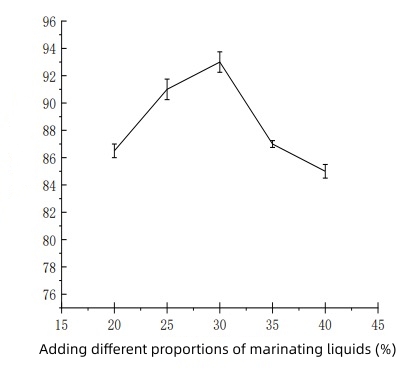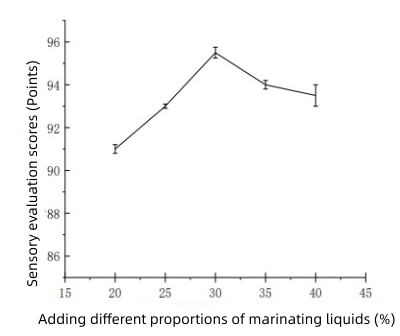Effects of Different Factors on the Quality of Sauced Beef (Part One)
2.3.1 Effects of concentration of ginger juice on the quality of sauced beef
2.3.1.1 Effects of different concentrations of ginger juice on yield, water holding capacity and pH
Table 2-8 shows the changes in the yield and water holding capacity of the sauced beef with different concentrations of ginger juice cooked by a cooker.
Tables 2-8 Yield, water holding capacity and PH of sauced beef with ginger sauce of different concentrations
2.3.1.1 Effects of different concentrations of ginger juice on yield, water holding capacity and pH
Table 2-8 shows the changes in the yield and water holding capacity of the sauced beef with different concentrations of ginger juice cooked by a cooker.
Tables 2-8 Yield, water holding capacity and PH of sauced beef with ginger sauce of different concentrations
| The concentration of ginger juice (%) | Yield (%) | Water holding capacity (%) | PH (%) |
| 20 | 61.35±0.64c | 87.65±0.57a | 6.57±0.10a |
| 25 | 63.40±0.75a | 89.36±0.36b | 6.70±0.02a |
| 30 | 66.48±0.73ab | 92.63±0.49b | 6.75±0.03a |
| 35 | 65.37±0.69a | 90.25±0.42c | 6.73±0.02a |
| 40 | 62.18±0.56b | 88.31±0.47d | 6.74±0.04a |
As shown in Tables 2 to 8, with the increase in the concentration of ginger juice, the changing trend of yield and water holding capacity increased first and then decreased, and the effect was significant (P being less than 0.05). The best indicator was when the concentration of ginger juice was 30%. The main tenderizing composition in ginger juice is ginger juice protease, which can promote the hydrolysis of structural protein in meat, thereby strengthening the tenderizing effect on the meat. When sauced beef is cooked by sous-vide cooking, enhanced hydrolysis can better prevent water loss. When the concentration of ginger juice is higher than 30%, the meat structure is over enzymatical; the yield and water holding capacity begin to decline for the muscle fragments, accompanied by a great loss of water and nutrients in the meat. Under the influence of ginger juice, the pH value showed a slight change, which first increased and then decreased, but the effect was not significant (P being greater than 0.05).
2.3.1.2 Effects of different concentrations of ginger juice on texture and shear force
The effects of adding different concentrations of ginger juice on texture and shear force are shown in Tables 2 to 9.
Tables 2-9 Texture and shear force of sauced beef with different concentrations of ginger juice
| The concentration of ginger juice (%) | Toughness (N) |
Elasticity (mm) |
Chewiness (mJ) |
Shear force (N) |
| 20 | 37.90±1.04a | 3.47±0.41ab | 60.35±1.32a | 73.59±1.75b |
| 25 | 35.41±0.95b | 3.83±0.12a | 62.35±1.44c | 72.46±1.43a |
| 30 | 33.32±1.01c | 4.39±0.32bc | 65.03±1.29b | 70.81±1.54a |
| 35 | 34.26±0.82c | 4.18± 0.32c | 65.53±0.98bc | 68.32±1.68ab |
| 40 | 36.11±0.29c | 3.94±0.13ab | 63.75±1.15c | 67.55±1.09c |
The texture is closely related to the water holding capacity. In Tables 2 to 9, elasticity and chewiness first increased and then decreased, while hardness and shear force had the opposite trend (P being less than 0.05). Ginger protease promotes the hydrolysis of muscle protein, and with the continuous increase in the concentration, the promoting effect is continuously strengthened; the corresponding shear force and hardness gradually decrease. The elasticity increases with the strengthening of hydrolysis. However, when the hydrolysis progresses to a certain stage, the muscle tissue structure is destroyed and begins to lose water and tighten, and the elasticity and chewiness increase accordingly. The oxidation of the sulfhydryl group of ginger protease also leads to a decrease in enzyme activity and weakens the tenderizing effect.
2.3.1.3 Sensory evaluation of ginger juice with different concentrations
The sensory evaluation of adding ginger juice of different concentrations is shown in Figure 2-1.

Figure 2-1 Sensory evaluation of adding ginger juice of different concentrations
When the concentration of ginger juice was 30%, the sensory evaluation score was the highest, that is 93. With the increase in concentration of ginger juice, the sensory evaluation scores increased first and then decreased significantly (P being less than 0.05). Ginger juice can fully tenderize the sauced beef. Ginger juice with a concentration of 30% can not only improve the taste of sauced beef, its special flavor can also play a role in removing the flavor of meat and enhancing flavor. When the concentration of ginger juice is too high, there will be obvious flavor of ginger in the meat, and the meat texture will also decrease, resulting in the sensory score being decreased. Considering the taste and texture, when the concentration of ginger juice is between 25% and 35%, better sauced beef can be obtained.
2.3.2 Effects of marinating liquids on the quality of sauced beef by sous-vide cooking
2.3.2.1 Effects of different proportions of marinating liquids on yield, water holding capacity and pH
Tables 2 to 10 shows the effects of adding different proportions of marinating liquids on the yield, water holding capacity and pH of sauced beef in the rubbing process.
Tables 2 to 10 Yield, water holding capacity and PH of sauced beef with marinades with different proportions
| Marinades with different proportions (%) | Yield (%) |
Water holding capacity (%) | PH (%) |
| 25 | 67.34±0.63a | 88.56±0.24b | 6.59±0.10a |
| 30 | 66.39±0.49d | 89.87±0.35c | 6.57±0.07a |
| 35 | 64.27±0.51ab | 93.10±0.37a | 6.57±0.08a |
| 40 | 63.28±0.43b | 91.43±0.51a | 6.56±0.02a |
| 45 | 63.15±0.56c | 87.32±0.42ab | 6.53±0.05a |
In Tables 2 to 10, the yield continued to decrease with the increase in the proportion of marinating liquids and remained unchanged when the proportion of marinating liquid exceeded 40% (P being less than 0.05). The contact area of the marinating liquid increases, and the absorbed water increases; more water will be lost during heating. When the absorption of water reaches the maximum, continuing to add the marinating liquid will not have any more effect. Under the influence of different proportions of marinates, the water holding capacity first increased and then decreased (P being less than and equal to 0.05). Adding a small amount of marinating liquid has a tenderizing effect. When the content of salt in the marinating liquid is high, too much salt will enter the meat through rubbing, which will cause the cells of the sauced beef to lose water and reduce the water holding capacity. The ratio of adding marinating liquid had no significant effect on pH (P being greater than 0.05).
2.3.2.2 Effects of different proportions of marinating liquids on texture and shear force
The effects of adding different proportions of marinating liquid on the texture and shear force of sauced beef are shown in Tables 2 to 11.
Tables 2-11 Texture and shear force of sauced beef with different proportions of marinating liquids
| Proportions of marinating liquids | Toughness (N) |
Elasticity (mm) |
Chewiness (mJ) |
Shear force (N) |
| 25 | 37.11±0.51a | 3.64±0.21b | 66.87±1.32a | 74.24±1.47a |
| 30 | 34.88±0.43b | 4.52±0.10a | 65.39±0.95a | 70.68±1.24bc |
| 35 | 33.46±0.46c | 4.28±0.23a | 63.73±1.24b | 67.52±1.39b |
| 40 | 33.32±0.68c | 3.83±0.17b | 64.36±0.73c | 66.85±0. 85c |
| 45 | 33.26±0.53c | 4.55±0.28a | 64.17±1.03c | 65.49±1.52a |
With the increased ratio of marinating liquid, the hardness decreased gradually (P being less than and equal to 0.05). The changing trend of elasticity and chewiness was not obvious. The shear force decreased with the increase in the proportion of the marinating liquid (P being less than 0.05), and the change rate was from fast to slow, which may be due to the obvious effect of the marinating liquid on the tenderization of the meat in the early stage. The marinating liquid absorbed in the medium is saturated, so the change tends to be stable.
2.3.2.3 Sensory evaluation of different proportions of marinating liquids
See Figure 2-2 for the sensory evaluation of sauced beef when adding different proportions of marinating liquids.

Figure 2-2 Sensory evaluation of adding different proportions of marinating liquids
When the proportion of marinates added was 30%, the sensory evaluation score was the highest, which was 95. With the increase in the proportion, it first increased and then decreased significantly (P being less than 0.05). When the proportion of marinating liquid added is low, hardness and shearing force of the beef are good and great. As the proportion of marinating liquid increases, the beef is more tender. When the proportion of marinating liquid is too high, the meat is dark and saltier and the sensory evaluation score decreased. According to the above analysis, the addition of marinating liquids with the proportion of 25% to 35% helps to optimize the flavor and quality of sauced beef.